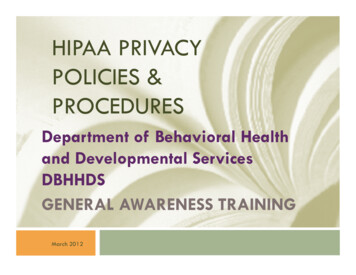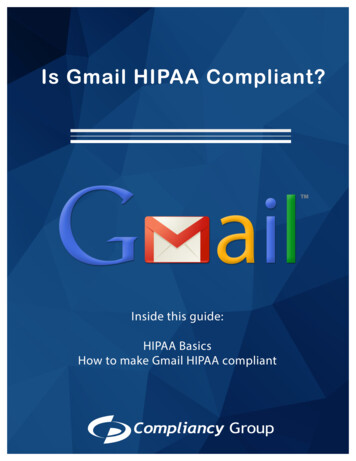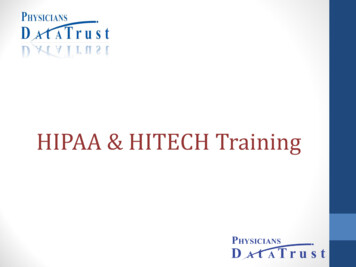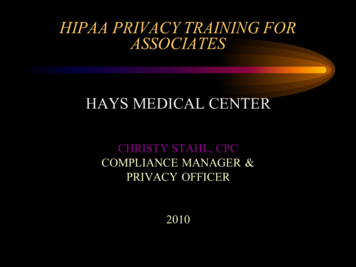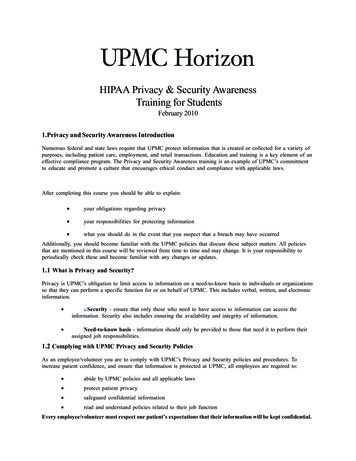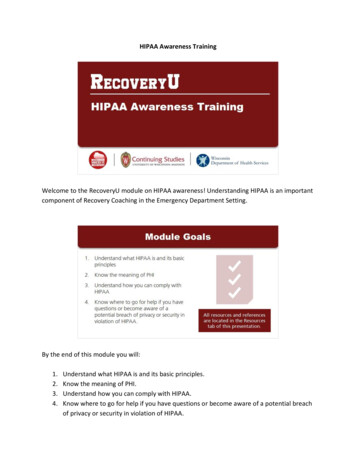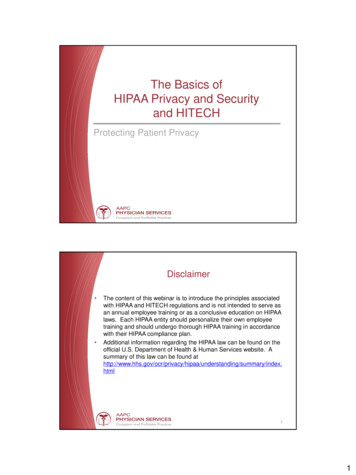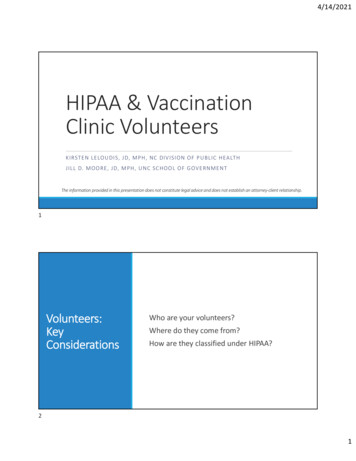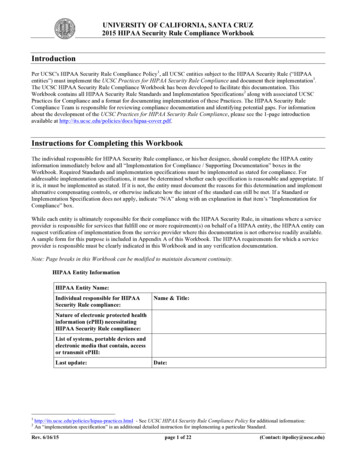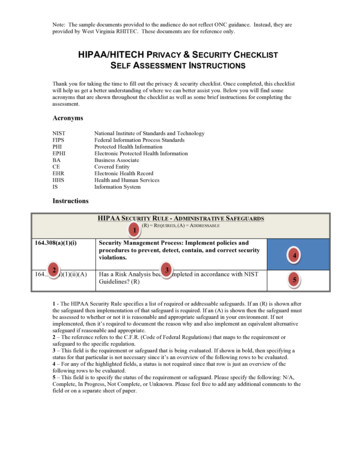
Transcription
Becoming HIPAACompliant with Verkada
BackgroundIn 1996, the Health Insurance Portability and Accountability Act (HIPAA) wascreated in order to establish modern standards to regulate the maintenanceand access of healthcare information. HIPAA, also known officially as theKennedy-Kassenbaum Act, consists of five titles that each provide stipulationsfor a specific area of the Healthcare and Health Insurance industries. The mostnotable of these is Title II, which serves as the basis for security and privacyprotections over personally identifiable patient records.Who must comply with HIPAA?The Department of Health and Human Services stipulates that HIPAA must be followed by all“covered entities” including: Healthcare Providers (including hospitals, medical centers, clinics, physicians, pharmacies, andnursing homes) Health Plans (including company health insurers, health plans, health maintenance organizations(HMOs), and government programs that pay for healthcare) Healthcare Clearinghouses Business Associates who sign a specific legal agreement with one of these organizations (Verkada isan example of a Business Associate, see below)How is HIPAA enforced?HIPAA is enforced primarily by The Department of Health and Human Services Office for Civil Rights(OCR). The Health Information Technology for Economic and Clinical Health (HITECH) Act of 2009extends similar investigative authority to the State Attorneys General. Upon receiving a complaint orreport of a security breach, the OCR begins conducting an investigation or general audit dependingon the severity and specificity of the violation.When the investigation or audit concludes, OCR determines if any HIPAA regulations wereinfringed upon and provides assistance in reestablishing compliance if necessary. Serious casesof noncompliance can result in punitive action including financial penalties and potentially evencriminal charges if the neglect is provably willful. Violation penalties can total up to 1.5 Million peryear if noncompliance remains unaddressed within 30 days of discovery.verkada.comCopyright Verkada Inc. All rights reserved.2
HIPAA Violation PenaltiesTIER 1 100 - 5,000 per violationUnaware of the HIPAA violation and by exercisiginMaximum 25,000 per yearrasonable due diligence would not have known HIPAARules had been vilated.TIER 2 1,000 – 50,000 per violationReasonable casue that the covered entity knew aboutMaximum 100,000 per yearor should have known about the violation by exercisingreasonable due diligence.TIER 3 10,000 – 50,000 per violationWillful neglect of HIPAA Rules with the violation correctedMaximum 250,000 per yearwithin 30 days of discovery.TIER 4 50,000 per violationWillful neglect of HIPAA Rules and no effort made toMaximum 1.5 million per yearcorrect the violation within 30 days of discovery.verkada.comCopyright Verkada Inc. All rights reserved.3
Title II – The AdministrativeSimplification ProvisionsTitle II of HIPAA codifies rules for maintaining the security and privacy of individually identifiable healthinformation. These provisions, known as the Administrative Simplification rules, require the Department ofHealth and Human Services (HHS) to establish specific standards for the protection and use of healthcareinformation. Accordingly, the HHS created a number of rules that have become the basis for what most referto as HIPAA compliance.The Privacy RuleSince the adoption of HIPAA, the HHS has established a number of regulations for the access and disclosureof Protected Health Information (PHI). These regulations are collectively known as Standards for Privacy ofIndividually Identifiable Health Information, or simply “The Privacy Rule.”Is surveillance footage consideredprotected health information?In some cases, yes.While Protected Health Information usually refers to secure records such as medical history andpayment information, the HHS defines it as “individually identifiable health information [ ] in anyform or media, whether electronic, paper, or oral.” So, generally speaking, if footage can be usedto directly identify an individual and their treatment, it must be protected under Title II of HIPAA.This could include footage from a patient’s room or from another treatment area such as anoperating room.Footage of common areas such as entranceways, waiting rooms, or storage closets are thus notconsidered HIPAA and can be shared or stored with fewer ecurity/guidance/index.htmlverkada.comCopyright Verkada Inc. All rights reserved.4
The basic tenet of this rule is defined by the HHS: “A covered entity may not use or disclose protected healthinformation, except either: (1) as the Privacy Rule permits or requires; or (2) as the individual who is the subjectof the information (or the individual’s personal representative) authorizes in writing.” Cases where PHI can bedisclosed are listed for reference on the HHS website.In 2009, Title II was amended by the HITECH Act to extend to Business Associates who handle PHI as well.Previous to this, only Covered Entities themselves were required to adhere to HIPAA regulations.The Security RuleIn order to protect and ensure the privacy afforded to patients by the Privacy Rule, the HHS published theSecurity Standards for the Protection of Electronic Protected Health Information, also referred to as “TheSecurity Rule.” As the title implies, the Security Rule extends protections of the Privacy Rule to records thatare stored and transferred electronically rather than physically.From the HHS website: “The Security Rule operationalizes the protections contained in the Privacy Rule byaddressing the technical and non-technical safeguards that [Covered Entities] must put in place to secureindividuals’ electronic protected health information (e-PHI).Specifically, Covered Entities and their Business Associates must:1.Ensure the confidentiality, integrity, and availability of all e-PHI they create, receive, maintain or transmit2.Identify and protect against reasonably anticipated threats to the security or integrity of the information3.Protect against reasonably anticipated, impermissible uses or disclosures4. Ensure compliance by their workforceverkada.comCopyright Verkada Inc. All rights reserved.5
Verkada’s Approach toHIPAA ComplianceThe Security Rule lists a number of safeguards to guide organizations in howthey manage and protect data. As a Business Associate, the Verkada solutionis designed specifically with features that comply with each.Administrative SafeguardsSecurity Management Process[45 C.F.R. § 164.306(e)]A covered entity must identify and analyze potentialVerkada Surveillance and Access Control systems canrisks to e-PHI, and it must implement security measuresbe used to actively monitor secure sites where e-PHI isthat reduce risks and vulnerabilities to a reasonable andaccessed or stored.appropriate level.Verkada performs frequent security audits of its storageand transfer of e-PHI. Read more about Verkada Securityat www.verkada.com/securitySecurity Personnel[45 C.F.R. § 164.308(a)(2)]A covered entity must designate a security official who isVerkada employs a staff of Cloud Security officials whoresponsible for developing and implementing its securityregularly deploy updates to the security of e-PHI storage.policies and procedures.verkada.comCopyright Verkada Inc. All rights reserved.6
Information Access Management[45 C.F.R. § 164.308(a)(4)(i)]Consistent with the Privacy Rule standard limiting uses andVerkada Command features Role Based Access Controldisclosures of PHI to the “minimum necessary,” the Security(RBAC), allowing for “minimum necessary” permissions grantedRule requires a covered entity to implement policies andon the individual and organizational level.procedures for authorizing access to e-PHI only when suchaccess is appropriate based on the user or recipient’s role (rolebased access)Information Access Management[45 C.F.R. § 164.308(a)(4)(i)]A covered entity must provide for appropriate authorizationVerkada systems are simple to set up and operate, allowing forand supervision of workforce members who work with e-PHI.minimal time invested in training personnel on its use.A covered entity must train all workforce members regardingits security policies and procedures, and must have and applyappropriate sanctions against workforce members who violateits policies and procedures.verkada.comCopyright Verkada Inc. All rights reserved.7
Physical SafeguardsFacility Access and Control[45 C.F.R. § 164.310(a)]A covered entity must identify and analyze potentialVerkada Access Control makes it easy to assign physicalrisks to e-PHI, and it must implement security measuresaccess to only the right parties. Tiered, role-basedthat reduce risks and vulnerabilities to a reasonable andpermissions simplify the process of giving new users theappropriate level.correct level of access.Workstation and Device Security[45 C.F.R. § 164.308(a)(2)]A covered entity must implement policies and proceduresVerkada Cameras and Access Control can be installed into specify proper use of and access to workstations andkey locations such as workstations to actively monitor howelectronic media. A covered entity also must have in placethey’re being used.policies and procedures regarding the transfer, removal,disposal, and re-use of electronic media, to ensureappropriate protection of electronic protected healthinformation (e-PHI).verkada.comCopyright Verkada Inc. All rights reserved.8
Technical SafeguardsAccess Control[45 C.F.R. § 164.312(a)]A covered entity must implement technical policies andVerkada partners with the most trusted Single Sign-Onprocedures that allow only authorized persons to accessidentity providers in the industry. Traditional Multi-electronic protected health information (e-PHI).Factor Authentication is available as well.Audit Controls[45 C.F.R. § 164.308(a)(2)]A covered entity must implement hardware, software,Verkada Command features comprehensive auditand/or procedural mechanisms to record and examinelogs that record the identity of anyone who hasaccess and other activity in information systems thataccessed the system and any changes that they havecontain or use e-PHI.made.they’re being used.Integrity Controls[45 C.F.R. § 164.312(c)]A covered entity must implement policies andVerkada data is stored redundantly across multipleprocedures to ensure that e-PHI is not improperlylocal AWS servers. Even in the unlikely event thataltered or destroyed. Electronic measures must be putone data center is compromised or disabled, e-PHIin place to confirm that e-PHI has not been improperlywill be preserved.altered or destroyed.verkada.comCopyright Verkada Inc. All rights reserved.9
Transmission Security[45 C.F.R. § 164.312(E)]A covered entity must implement technical security measuresAll Verkada data is encrypted in transit using the AES 128 andthat guard against unauthorized access to e-PHI that is beingTLS v1.2 algorithms. Whether footage is being sent to the cloudtransmitted over an electronic networkor accessed by a mobile device, e-PHI is safe from unauthorizedinterception.Verkada is trusted by over250 Healthcare OrganizationsWant to Learn More about our HIPAA compliant solution?Get a Free Trial
Unaware of the HIPAA violation and by exercisigin rasonable due diligence would not have known HIPAA Rules had been vilated. Reasonable casue that the covered entity knew about or should have known about the violation by exercising reasonable due diligence. Willful neglect of HIPAA Rules with the violation corrected within 30 days of discovery.
